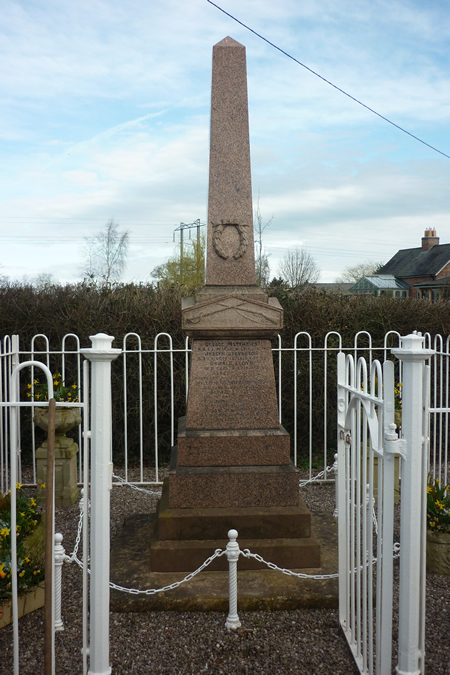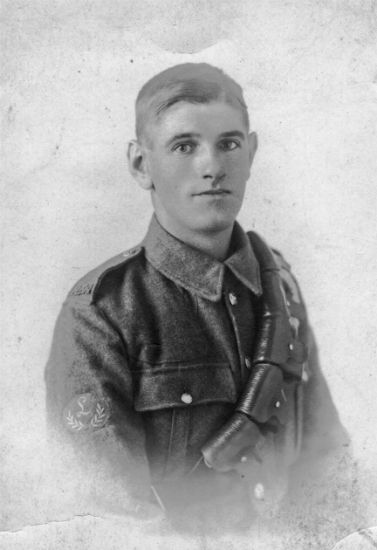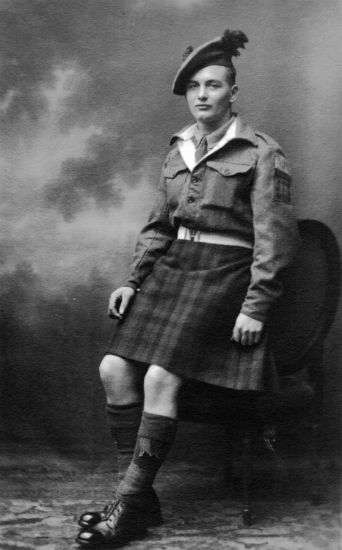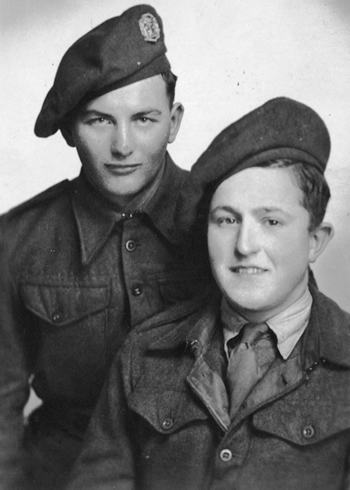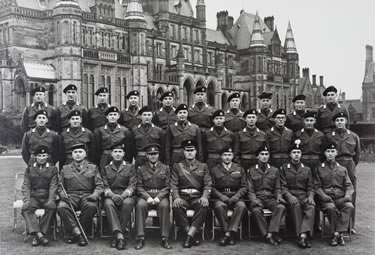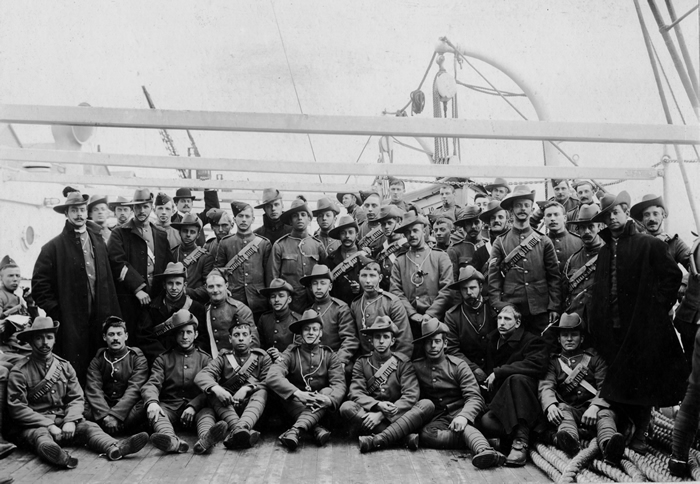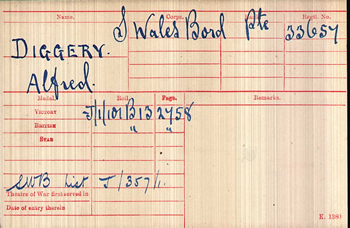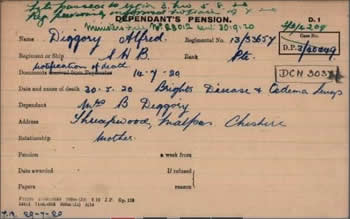Threapwood's Military Past
From the Civil War of the 17th Century to more modern conflicts Threapwood has played its own small part. As our group gathers information about the people and events involved their details will be added here.
War Memorial - by Dorothy Powell
Like many villages throughout the UK Threapwood has its own memorial to Servicemen and Servicewomen who fell in past conflicts. The Threapwood War Memorial is located at the junction of Sarn Road and Chapel Lane and is extremely well maintained throughout the year by local volunteers.
The memorial is inscribed with the names of both local people and those who had some form of association with the village and, unlike many other war memorials across the United Kingdom, includes only names from the Great War. In January 1920 the children of Threapwood National School wrote an essay about the unveiling of the War Memorial which had been unveiled by General Grattan assisted by Colonel H. McLean and Reverend Plaskett.
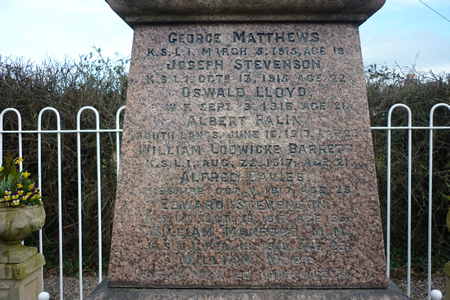 |
Inscriptions (Click to enlarge) |
Service Details
The details of each persons service record including the place of their burial is given below. Most service people were buried in cemeteries created and now maintained by the Commonwealth War Graves Commission. By following the links below it is possible to see either an image of the CWG Cemetery or the actual headstone for each individual. The names are in the order inscribed on the memorial.
| Name | Rank & Number | Service | Died | Age | Where Buried |
| George MATTHEWS |
Private 9925 |
King's Shropshire Light Infantry (1st Bn. |
5/3/1915 | 18 | Ploegsteert Memorial, Hainaut, Belgium |
| Joseph STEVENSON |
Private 16591 |
King's Shropshire Light Infantry (6th Bn.) |
12/10/1915 | 21 | Rue-de-Bacquerot No.1 Military Cemetery, Laventie, Pas de Calais, France. |
| Oswald LLOYD |
Private 25805 |
Welsh Regiment (2nd Bn.) | 9/9/1916 | 21 | Heilly Station Cemetery, Mericourt-L'abbe, France |
| Albert PALIN |
Private 31662 |
South Lancashire Regiment (8th Bn.) |
16/6/1917 | 21 | Bailleul Communal Cemetery Extension, Nord, France. |
| William Lodwick BARRETT |
Private 239287 |
Herefordshire Regiment attached to the King's Shropshire Light Infantry (5th Bn.) |
22/8/1917 | 21 | New Irish Farm Cemetery, West-Vlaanderen, Belgium. |
| Alfred DAVIES |
Private 52703 |
Cheshire Regiment (1st Bn.) |
7/10/1917 | 29 | Tyne Cot Memorial, West-Vlaanderen, Belgium. |
| Edward STEVENSON |
Private 203653 & 4677 |
Duke of Edinburgh's Wiltshire Regiment (1/4th TF Bn.) formerly Cheshire Regiment |
18/10/1917 | 34 | Hadra War Memorial, Alexandria, Egypt. |
| William MANFORD |
Corporal 14962 |
King's Shropshire Light Infantry (7th Bn.) |
13/2/1918 | 23 | Boyelles Communal Cemetery Extension, Pas de Calais, France. |
| William MORT | Gunner 160900 |
Royal Garrison Artillery | 20/5/1918 | 31 | Brandhoek New Military Cemetery No. 3, West-Vlaanderen, Belgium |
Biographical Notes
We have tried to collect as much biographical detail available to us for each person remembered on the memorial. We would be happy to add further details from any friends and relatives.
George Mathews
Private George Matthews 9925 King’s Shropshire Light Infantry 1st. Bn.was born at Chalk Farm, Middlesex on the 12th. January 1896 to Threapwood born George Matthews and his wife Jane. The family were in Poplar, Middlesex in 1891, in Toxteth Park, Liverpool in 1901, in Threapwood on 14 July 1902 when George enrolled at Threapwood National School. It is thought George left school on 15th. January 1907 and was last recorded living in Whitchurch in 1911. He died on 5th. March 1915 aged 18 years and is commemorated on Ploegsteert Memorial, Hainaut, Belgium.
Edward Stevenson
Private Edward Stevenson 203653 Duke of Edinburgh’s Wiltshire Regiment 1/4th.Bn. and formerly 4677 Cheshire Regiment, son of William and Elizabeth Stevenson of Threapwood died on 18th. October 1917 of Malaria and is also commemorated on the Malpas War Memorial. He was a farm labourer lodging with the Kettell family at Overton Common, Malpas in 1911.
Joseph Stevenson
PRIVATE Joseph Stevenson 16591 King’s Shropshire Light Infantry 6th. Bn. Born at Overton, Malpas son of William and Elizabeth Stevenson died 12th October 1915 buried Rue-de-Bacquerot No.1. Military Cemetery, Laventie, Pas de Calais, France. Also commemorated on the Malpas War Memorial. He was working at Wychough Farm as a pig man for Thomas Done in 1911.
Oswald Lloyd
Private Oswald Lloyd 25805 Welsh Regiment 2nd. Bn. was born in Threapwood on 10 June 1895 the son of Sarah Jane Lloyd , enrolled at Threapwood National School on 3rd. September 1900 and lived at Bootle Cottage (now called Windsor Cottage) Oldcastle Lane. He died on 9th.September 1916 aged 21 years and is buried in Heilly Station Cemetery, Mericourt - L’Abbe, Somme, France. He was living with his Grandmother Betsy Lloyd in Threapwood at the time of the 1911 Census. His Grandmother is listed as a "Farmer" in 1911 so presumably Oswald, at that time aged 16, worked on the farm. At the time of his enlistment in 1914 he lived at Rose Villa in Threapwood and was listed as a Seaman. He noted his mothers name as "Lissie" presumably a nick name and apparently sported a number of Tattoos on his arms when he enlisted.
Albert Palin
Private Albert Palin 31662 South Lancashire Regiment 8th. Bn. the son of Samuel and Elizabeth Palin was born on 2nd. August 1895 at Saighton, Chester and lived in Chester in 1901 with his parents. He attended Threapwood National School from 16th. October 1906. People who knew Albert say he spoke with a stammer. The 1911 Census showed Albert working on a farm and together with his sister Margaret living in Frontier House with his Uncle, Charles Palin. He died on 16th. June 1917 aged 21 years and is commemorated at Bailleul Communal Cemetery Extension, Nord, France.
William Lodwicke Barrett
Private William Lodwicke Barrett 239287 King’s Shropshire Light Infantry 5th. bn. was born at Threapwood and baptised at St.John’s Church the son of James and Eliza Ann nee Clarke. The family lived up Greaves lane, the house no longer there. William was educated at Threapwood National School. He died on 22nd August 1917 aged 22 years and is buried in New Irish Farm Cemetery, West Vlaanderen, Belgium. His father was recorded as being a Chauffeur in William's will dated 1919 in which he left £42.1s.2d.
Alfred Davies
Private Alfred Davies 52703 Cheshire Regiment 1st.Bn was born in Malpas and baptised at St.Oswald Church, Malpas on 2nd. January 1889 the son of Henry & Annie Davies. Their house in Threapwood was on the corner of Sarn Road and Back Lane. He died on 7th. October 1917 aged 29 years and is commemorated on the Tyne Cot Memorial, West Vlaanderen, Belgium. He worked with his father as a farm labourer at the time of the 1911 Census.
William Manford
Corporal William Manford 14962 King’s Shropshire Light Infantry 7th. Bn.The son of Joseph & Mary Ann Manford was born on 3 November 1895, baptised William Powell Manford on 17th. January 1895 and enrolled at Threapwood National School on 20 April 1898. He died on the 13th. February 1918 aged 23 years and is buried in Boyelles Communal Cemetery extension, Pas de Calais, France. On the 5th. March 1918, almost a month after his death, a note in the daily Log Book of Threapwood School stated that news had been received that Willie Manford had been shot and that he had won the MILITARY MEDAL. At the time of the 1911 Census and aged 16 William was working as a cow hand for local farmer Jane Moore.
William Mort
Gunner William Mort 160900 Royal Garrison Artillery was son of Joseph and Mary Mort who lived on Greaves Lane East. In 1911 he was a farm labourer for Mrs. Matthews at Halghton Hall, Bangor on Dee and on the 4th. February 1913 he married Edith Ellen Jones at St.Oswald Church, Malpas. He joined up at Wrexham and died on 20th. May 1918 aged 31 years. He is commemorated in Brandhoek New Military Cemetery No.3, West- Vlaanderen, Belgium, His name is also on the War Memorial at Bangor on Dee and the North Wales Heroes Memorial Arch, Bangor, Gwynedd he having worked in Bangor on Dee parish. He and his wife Edith lived at Sunnyside in Chorlton Lane prior to his enlistment. His mother is remembered as a person who did a lot of knitting for people locally.
Military Medal
As mentioned above Threapwood's contribution to the war was recognised by the award of the Military Medal in May 1917 to William Manford who died the following February. The Military Medal was also awarded to two soldiers not named on the memorial namely Corporal Richard Stevenson 16779 6th Battalion Shropshire Light Infantry. Richard, known as Dick, was the younger brother of Edward and Joseph named above. Sergeant Lancelot Vaughan 27321 Royal Garrison Artillery of Tallarn Green and Threapwood was also awarded the Military Medal in August after the war had ended. It is believed he also was awarded the Croix de Guerre.
 |
The Military Medal (MM) was awarded from 1916 till 1993 and was awarded for bravery in battle on land.Over 115,000 awards were made for actions during the First World War. | |
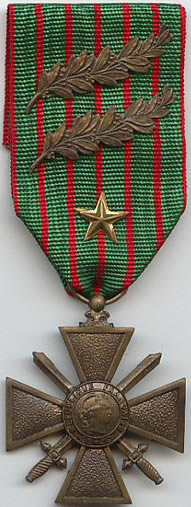 |
The Croix de guerre was awarded as an individual or unit award to those soldiers who distinguished themselves by acts of heroism involving combat with the enemy. The medal is awarded to those who have been "mentioned in despatches", meaning a heroic deed or deeds were performed meriting a citation from an individual's headquarters unit. |
Threapwood's Volunteers
The Whitchurch Herald recorded the names of many local men who volunteered. It's sad to see the names of some of those listed below feature on the Memorial.
As reported in the WHITCHURCH HERALD 6th. December 1914
THREAPWOOD men who had gone to war.
ALFRED WILLIAMS
WILLIAM MANFORD
GEORGE MATTHEWS
WILLIAM MATTHEWS King’s Shropshire Light Infantry
ALF PENLINGTON
ELLIS MANFORD Royal Welsh Fusiliers
JAMES L LARGE
FRED CRUMP
WALTER JONES South Lancashires
LEVI MANFORD R F A
THOMAS ROSCOE R F A NCO Drilling
WILLIAM JAMES
FRED GROOM
NUGENT BACCONS R F A
Others, from or having connections to THREAPWOOD, who joined up later.
WILLIAM LODWICK BARRETT
JIM BLYTHING
WILLIAM BLYTHING
ALFRED DAVIES
JOHN DIGBY
OSWALD LLOYD
WILLIAM MORT
ALBERT PALIN
EDWARD STEVENSON
JOSEPH STEVENSON
RICHARD STEVENSON
LANCELOT VAUGHAN
Gallery
The group has just a few photographs of local men who served in the various conflicts. The small gallery below includes those that have been made available. If you have a photograph of a local Threapwood person you would like included please contact our Chairman.
A surprising Find - by David Roderick
During the summer of 2010,whilst working on a drainage ditch on the southern boundary, western side of the field belonging to myself and my wife Sarah, adjoining Chapel Lane,Threapwood, I found a metal object, not initially identifiable as anything in particular. After cleaning, the letters SWB were visible, below the form of a sphinx and the title Egypt. Closer examination revealed that the bent and battered object was a cap badge of the South Wales Borderers, The Royal Regiment of Wales.
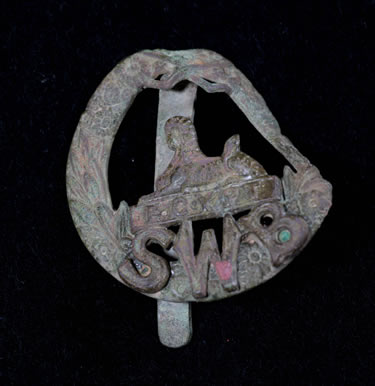 |
A rather battered badge found in a drainage ditch. |
The sphinx, superscribed Egypt was awarded as a battle honour to the 24th Regiment (later to become the South Wales Borderers) in July 1802, after a successful campaign against the forces of Napoleon in Egypt. The sphinx was later used as the centre piece of the cap badge and the collar badges of the South Wales Borderers.
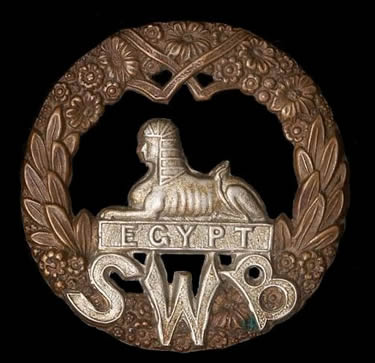 An unblemished version.
An unblemished version.
Although no battalions of the SWB were based in Threapwood or the immediate area, the
following battalions were based in the midlands, north west of England and north Wales:
10th (Service) battalion (1st Gwent). 1914 moved to Colwyn Bay and attached to 130th
Brigade, 43rd Division.
9th (Reserve) Battalion. 10th April 1915 became a reserve battalion and moved to Kinmel
Park (Rhyl).
3rd (Reserve) Battalion. moved in June 1915 to Hightown near Liverpool for duty as part of
the Mersey Garrison.
12th (Service) Battalion (3rd Gwent). Moved in July 1915 to Prees Heath.
13th (Reserve) Battalion. Formed at St Asaph in July 1915 as a Reserve Battalion. Moved
in September to Kinmel Park(Rhyl).
14th (Reserve) Battalion. Formed at Prees Heath in September 1915 as a Reserve
Battalion. Moved to Conwy in October 1915 but moved on to Kinmel Park (Rhyl) in
January 1916.
The insignia of the South Wales Borderers appears on the headstone of A. Diggory
Private 33657 died 1920 in St Johns Church Yard in Threapwood. I assume that Private
Diggory was a resident of Threapwood. (See Below)
Local Military Historian John Minoprio writes:
I am delighted to see David Roderick's happy find in honour of that famous regiment The South Wales Borderers. It is remarkable that, in these days of Ministry of Defence cuts, the South Wales Borderers had 18 battalions in the Great War. The Regiment proved itself more than 200 years before World War 1 when it won its first battle honour at Blenheim.The 24th is best known for its heroic stand in the Zulu War in January 1879.
Having been almost completely wiped out at Isandlwana, on the same day at Rorke's Drift, 104 men of the South Wales Borderers beat off repeated attacks by 3000 Zulus for about 12 hours. For its valour in these actions the Regiment won 9 Victoria Crosses and the honour of bearing a wreath of silver laurels attached to the Queen's Colour. My own link with the regiment was formed a dozen miles from Threapwood, at the Officer Cadet School at Eaton Hall more than 50 years ago.
Pictured below is 17 Platoon C Company photographed against the Gothic grandeur of the Hall designed by the famous Victorian architect Alfred Waterhouse.We were young, but we were in very good hands. The Company Commander, Major R.H.W. Fowler, seated front row, was a South Wales Borderer.
Cheshire Regiment - Boer War
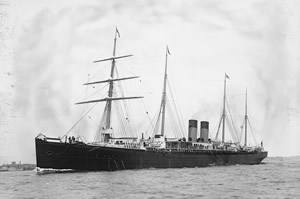 |
The 2nd Battalion sailed on the Britannic (pictured right) about 7th January 1900, arriving about the 27th. Along with the 2nd South Wales Borderers, 1st East Lancashire, and 2nd North Staffordshire, they formed the 15th Brigade under Major General A G Wavell, and part of the VIIth Division under Lieutenant General Tucker.
The Cheshires had no very serious fighting on the way from Modder River to Bloemfontein. In the action at Karee Siding on 29th March the infantry employed was the VIIth Division, and this battalion was said to have done well. They had about 22 wounded. At the Zand River the battalion was sent forward on the evening of the 9th May to seize and hold a drift. This they successfully accomplished, and the brigade crossed early on the 10th, clearing the enemy from strong positions north of the river.
After the occupation of Johannesburg the 15th Brigade was detailed to garrison the town, and the Cheshire Regiment long remained in that vicinity.
Eight officers and 12 non-commissioned officers and men were mentioned in Lord Roberts' final despatch.
On 5th December 1900 the battalion relieved the 2nd Royal Scots Fusiliers as garrison of Frederickstad. In January 1901 part of the battalion was holding a post on the line south of Johannesburg when the enemy attacked fiercely. The attack was very gallantly driven off.
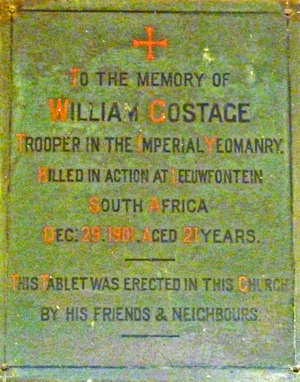 |
In 1901 the battalion furnished the infantry of columns under Sir H Rawlinson, Colonel E C Williams, Colonel Hickie, and other commanders, which did much arduous but useful work in the South-West Transvaal. Three officers, 1 non-commissioned officer, and 1 private were mentioned by Lord Kitchener for good work during the later phases of the war. In the final despatch 5 officers and 4 non-commissioned officers were mentioned.
St John's Church in Threapwood has a memorial to William Gostage who was killed at Bloemfontein on 29th December 1901 aged 21 years. Family sources recall that he was killed on Horseback, apparently a white horse.
In the photograph below William can be seen third from the right on the bottom row probably aboard the SS Brittanic when it sailed to South Africa on January 1900. Photo courtesy of Ron Jones.
|
Cheshire Regiment c 1900 |
Mystery CWG Headstone
In about 2015 the Commonwealth War Graves Commission placed a memorial in the churchyard of St John Threapwood to a Private A Diggory. The only available information about him at that time was that inscribed on the memorial. A plea here for more information was answered by Terry Fry from the Whitchurch Museum and Archives which is reproduced below.
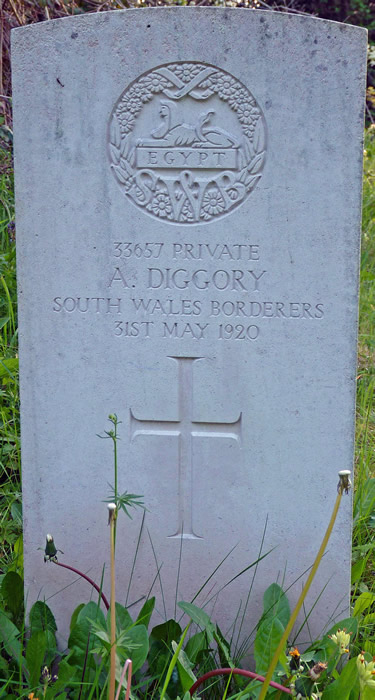 |
CWG Memorial in St Johns Churchyard. |
Alfred Diggory (or Diggery) served as Private 33657 in the South Wales Borderers. He died on 31 May 1920.
| The 1881 Census below shows Thomas and Bethia Diggery living in Threapwood with his widowed mother, Mary, and six children; John T, Hannah M, Jane, Elizabeth, Catherine and William. |
 |
| The 1891 Census below shows Thomas and Bethia Diggery living in Threapwood with five children; John, William, Sarah, Thomas and Frances, |
 |
| The 1901 Census below shows Thomas and Bethia Diggory living in Threapwood with one grandchild Francis. |
 |
| The 1911 Census below shows Thomas and Bethia Diggery living in Threapwood with two grandchildren; Alfred (Pte 33657 South Wales Borderers died 31 May 1920) and Vincent Henry. |
 |
From these records we cannot determine who are the parents for Francis, Alfred or Vincent Henry Diggery. We suspect that as all have the name Diggery (or Diggory) they are from the eight surviving children of Thomas and Bethia.
The most likely identification of Thomas and Bethia’s marriage is a marriage in 1864 in Wrexham between Thomas Diggery and Elizabeth Pritchard (hence the derivation Bethia).
Additional Biogaphical Notes on Albert Diggery (1897-1920)
The following additional notes, with links to original documents, have been provide by local residents Sylvia and David Hand who are relatives of Albert Diggery;
Alfred was cousin to my grandfather, Walter Henry Mellor aka Tom. His mother, Jane Diggery (1874-1953) and Tom's mother, Elizabeth Diggery (1875-1964) were sisters. According to Alfred's birth certificate he was born 8th September 1897 at 5 Yardington, Whitchurch, his mother is registered as Jane Diggery but the father is unknown.
Jane went on to marry Edwin Edwards in December 1898 and have three more children; Arthur, Ida and Nellie. They lived in Ellesmere. Alfred remained living with his grandparents Thomas Diggery (1844-1918) and Bathia Hewitt (1846-1924) in the family home Yew Tree Cottage (off Greaves Lane) in Threapwood.
Alfred was enrolled into Threapwood C of E School in 1902 by his grandfather Thomas. He enlisted in May 1916 and he fought with The South Wales Borderers. I think the spelling of Diggery/Diggory is largely due to the fact during the 1800's/1900's the majority of people had limited ability to read and write, therefore, when censuses etc. were done it was up to the person taking the details as to how names were spelt. Hence the different spelling of Diggery and also Bathia/Bethia/Bathiar).
According to Censuses from 1851 to the 1911 Census Bathia's place of birth is Egerton, Malpas. She was born on 15th March 1889 and baptised at Threapwood on the 31st March of that year. Alfred was injured in early 1918, he was returned to England and hospitalised in the Royal Infirmary in Chester where he remained until May 1920 when he died from Bright's disease and Oedema of the lungs. It would appear that his injuries were due to being gassed.
1918 was a sad time for Bathia as her husband Thomas died in February 1918, her grandson Alfred was badly injured and then she lost another grandson on 25th August 1918 as my grandfather's older brother Herbert John Mellor (Bertie) was killed in action in France. Bertie is remembered on the Vis-en-Artois memorial.
VINCENT HENRY DIGGERY
Vincent was born on 15th January 1910, his mother was Frances Bathia Diggery (1889-1970). She was a spinster when he was born and the father's name is not registered. Frances was the younger sister of my great grandmother, Elizabeth. The 1911 Census shows that Frances was a servant living in Wem and that Vincent was living with his grandparents in Threapwood.
Frances married John Bowen on 17th April 1912 at the Parish Church, Newtown, Wem. John Bowen has military records ( 1, 2 & 3) stating that he married Frances and that she had a son, Vincent Henry. Residence records for 1939 show Vincent living in Oxfordshire and working as a Trainee Metal Rigger. On the 14th May 1943 Vincent placed a notice in the London Gazette (left column notice #6) stating that he was changing his surname to HAYES. He died in February 1984 aged 74 in Lewisham, London.
Wartime Decoys in North Wales by Dudley Realff
During the early days of the Second World War it was quickly realised by the RAF that airfields, particularly in the south east of the UK would be under severe threat from the Luftwaffe. The German Air Force was not only well equipped with aircraft but had also been battle hardened during the Spanish Civil War so deception was considered as a means of defence.
To this end in a region where much land had already been acquired for genuine airfields, the Air Ministry bought some for what became known as ‘K’ sites. These early sites consisted of dummy hangers built of scaffolding and tarpaulins, some obsolete aircraft and dummies. These preparations alerted both the Navy and the Army to realise that the K sites had to be coordinated. Therefore a retired service engineer officer who had had experience of airfield construction was recruited. This man was Colonel Sir John Turner and he became head of the British Decoy and Deception team based at Shepperton in Middlesex. There, the film studio technicians and craftsmen were used to construct various items of dummy equipment, viz. boats, aircraft, buildings and even soldiers. These sites, despite some raids, did not attract the attention that had been hoped and by the mid 1940s when German raids took place at night rather than during the day, other deception methods had to be considered which became known as ‘Q’ sites. These did not require the amount of good land that dummy airfields did and consequently a different means of deception evolved. Poor land was used to make what it was hoped would be, from the air, seen as flare paths etc. So lights on poles were set up with a command shelter at a safe distance from the site where some poor fellow had to wait to be told to switch the lights on!
A more sophisticated system was developed whereby the string of lights were supplemented by low powered red lights to simulate some typical airfield buildings. This was sophisticated further with a system developed in Scotland which looked much more like a real site which was called DREM. There were boundary lights, red warning lights plus a lamp on site which resembled an aircraft taxiing. This system, alas, attracted numerous pilots returning home lost and perhaps short of fuel or damaged. These poor souls attempted to land, some not many successfully – sadly many died. To prevent this hooded red lights were installed which could only be seen by pilots on a glide path allowing them to abort the attempted landing.
A new system and classification of deception devices was thought necessary for cities and major towns. These were categorised as follows:-
- QL – decoy with lights
- QF (Starfish) - decoy with fire.
- DREM – a much more sophisticated system of decoy airfields.
The QL systems were electric light devices that were designed to suit the city/town or target that they covered. Some were used where lights were normally seen e.g. steelworks or marshalling yards. These systems used some very simple ideas like having sheep hurdles suspended over lights, which from the air, gave the effect of a moving light. Strobe lights were employed to appear as vehicles moving along a street. Also coloured lights gave the impression of signals on road or rail.
The QF system used fire on a restricted basis at first but these became much bigger using coal, diesel, paraffin, creosote and petrol. Basket fires were popular and numerous. All of these sites needed to be controlled and to this end control bunkers of various designs and construction were established at least 400m from the site. These would be manned by servicemen mostly and on larger sites there could be as many as 24 men, including an electrician, on duty who had to be in communication with an HQ on a RAF base for example. In many early cases someone from the site had to make his way either on foot or by bicycle to a telephone box to find out if anything was ‘on’. If not he would go back and wait however, if there was a raid pending he would dash back and activate whatever system was employed at his site. Most of these sites acquired telephones eventually. If the enemy sent over ‘Pathfinder’ aircraft which would illuminate a target with incendiaries, the idea was for firemen to extinguish them and at the same time the decoy system would be lit so that subsequent bombs fell harmlessly there. These systems were ignited by detonators placed in the fire baskets and activated from the control shelter. The Starfish systems used larger longer metal baskets capable of holding large quantities of inflammable material. For example one plan shows a basket containing 4cwt of wood, 3 tons of lump coal, sawdust, waste cloth and, in fact, anything that would burn - all soaked in creosote. The standard basket was plank sided and about 3 foot square which could contain alternative layers of creosote soaked wood shavings and other inflammables and wrapped in roof felt to keep them dry – there could be dozens of these on any one site. Once they were lit not only did they burn well but would glow afterwards giving enemy pilots the feel of success. Some sites used detonators in the baskets as well to give the impression of explosions to those above. On some bigger sites a large metal container was erected on scaffold poles with a pipe over the basket. The container would be filled with creosote, perhaps engine oil or the fluid which was used to ignite flare paths. When the fire in the basket was well alight then the flammable liquid would be dripped onto the glow. Various tricks were used to make this all seem, from the air, even more convincing. One snag was that these systems could not be employed on clear nights as pilots would notice that below was not a built up area. Otherwise these systems worked well and on one raid over Cardiff the Starfish site attracted 120 HE bombs and hundreds of incendiaries which would have otherwise fallen on the city.
The control sites changed, improved and grew in size as the war went on. The respective services also designed control buildings to suit their own ideas and needs. When the bombing of Britain diminished owing to Germany’s preoccupation with Russia and the tide turning in the Allies favour on the Western Front the ‘K’ sites were wound up and by 1944 all except a few around London were closed down. However, they had not been the success hoped for and Colonel Turner retired again in 1946.
So what of the decoys in our own area? North Wales was initially not considered to be in the front line so decoys were not organised as early as in the south east for example. However, as the war progressed targets such as Liverpool were identified by the German reconnaissance. The bomber routes to Liverpool passed over the area and vulnerable sites were deemed worthy of some decoy protection and consequently Starfish sites were constructed locally at Llandegla in 1941 followed by Llanasa and Fenns Moss by Whitchurch. Local sites like these were constructed to reduce the tonnage of bombs aimed at Liverpool.
FENNS MOSS - fire baskets were set up on 5 foot square concrete slabs which I believe still exist. Here the material to burn was, not surprisingly, supplemented by blocks of peat. These baskets had diesel fed from an overhead tank erected on scaffold poles. Eventually there were nine men here plus an NCO and a telephone was installed which saved someone having to cycle to The Waggoners Pub in Whixall to get the go-ahead. This site was closed in 1943. MARCHWIEL – where a decoy was established in July 1941 in order to take attention away from a Royal Ordanance factory manufacturing Nitro Glycerine and gun cotton etc. The site chosen was 3.5 miles away between Shocklach in the north and to the north east of Worthenbury. The site was located alongside a lane that runs to Hitchen’s farm and was run by the Army. It had the usual collection of fire baskets, troughs plus oil drip fires and interestingly the site was in England protecting a factory in Wales. It doesn't’t appear to have been activated and was taken out of commission in October 1943.
WREXHAM DREM was a dummy airfield 400m up Esclusham Mountain and was to protect an airfield built at Wrexham in July 1942 – a little late in the day! This decoy came into operation a month later in August. This area was also an Army training ground with hundreds of men firing all manner of weaponry. Nevertheless the construction of a dummy airfield went ahead and there were dummy aircraft, a flare path and dummy hangers made from scaffolding poles covered with tarpaulins. Also here there was a trio of runways simulating almost exactly the genuine airfield in Wrexham in fact it was so effective that it was used by trainees for landing practice. As indicated above this was rather late in the day and enemy bombings took place during the night and the decision was taken to extend the site to a full DREM with a longer flare path. Despite this there was little or no action and indeed later there were questions asked as to the reasons for building the decoy before the ‘real’ site. This airfield was only a training site and there was speculation that the decoy was on behalf of RAF Hawarden and the nearby Vickers factory producing Wellington bombers before the decoys at Bretton Hall were ready.
HARWARDEN decoy site was established in August 1941 and was situated 2 miles S.E. of the airfield near Bretton Hall and close to the A55. It was designed as a QF site and Vickers had their own QF site close to the Wrexham/Chester railway. The QF status was elevated to Starfish for the 6 months late in 1942 to the spring of 1943 when it reverted back to QF. Vickers had a dummy factory built which was, apparently, very convincing and was classed as a K site. The control centre, which had a considerable generator able to light a flare path and much more besides, has since been demolished but cultivation of nearby fields have revealed heavy duty electric cable.
CILCAIN, near Mold, was a QF site and it was felt that a decoy here was a necessity as there was a large chemical plant at Rhydymwyn which was used by ICI to produce explosives and chemical weapons. There were also miles of old mine workings used to store TNT and all of this was under the control of the Royal Ordanance Factory. The decoy was ready by August 1941 south of Cilcain and 2 miles from ICI. It consisted of large fire lit by detonators controlled from the control shelter. All of this could be activated, as described elsewhere, by a serviceman cycling to the Bryn Bannon phone box where he would speak to RAF Radlett who would inform him if a raid seemed imminent. Thankfully, neither the decoy, the factory nor the servicemen were ever attacked. The site, initially an Army responsibility, soon passed to the RAF and later there were rumours that ICI personnel took over. The remains of the control shelter can still be seen and the firing cables have been unearthed at times.
SEALAND QF at Puddington – it was decided to build a decoy site for this airfield and work started in July 1940. A considerable amount of electrical work had been carried out when in August the main airfield was bombed resulting in considerable damage. After two years work recommenced on an elaborate DREM system which was completed in August 1942. Ironically this turned out to be 3 days after the last all clear in the area as it was discovered that there were other decoy sites around the area of all types.
It would seem that hardly any of the decoy sites were ever attacked and a Hawarden it was the main target that was damaged. The main problem was during the time between German bombings and sites being ready German tactics had changed to night bombings. It was felt that had these decoys been in place in 1939 then the results would have been better? Of all the systems, and this is a reflection on GB as a whole, that Q sites worked quite well as did Starfish but in the other systems the ‘target’ lights were not bright enough.
After the war it was estimated that for the country, decoy sites attracted 5% of German bombs and this figure extrapolates to a statistical saving of 2596 dead and 3160 injured. After the sites became inoperative the land plus the control shelters were returned to the owners. Obviously, most of the fire baskets, electrics other paraphernalia were removed before handover. There are many brick built control shelters that can still be seen however, few will appreciate what function they once had.
Information for this summary has been gathered from Wartime Bombing Decoys in Wales written by Ivor Jones and compiled for Threapwood History Group by Dudley Realff.

